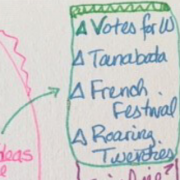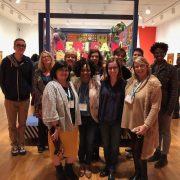How to be Digital (And Not Alienate People)
March 16, 2020
By Tom Dykes
Last year, while scrolling through the National Theatre Bookshop’s work feed over morning coffee (read: being easily distracted by Twitter), I came across an article on Medium by a digital marketing specialist, Lori Byrd-McDevitt, that really stayed with me.
“Museums have this funny problem of needing to keep up with the Joneses (other leisure time activities) but refusing to play in the same sandbox. For museum social media managers, it means keeping up with companies like Coca Cola and Disney with 0.01% of the budget that these monster accounts have … or sometimes no budget at all. Generally speaking, this is because museum leadership has been slow to understand the importance of digital as compared to traditional media, or the impact of social as a first touchpoint.”
This struck me for a few reasons, notably that you could swap out the job title and replace it with any number of roles in an arts institution. But it particularly appealed to my personal experience of juggling social media with several other roles in my day-to-day job. I’m sure many of us recognize the curse of working in the arts: that we love what we do and where we work and therefore should put up with more expectations (and workload) for less money than the private sector, precisely because of the “privilege” of working where we do and the understood squeeze on funds.
So, how do you do it? Through using what the private sector doesn’t have: the love, passion and sense of ownership our visitors have for our unique cultural organizations.
In my talk at MSA FORWARD, I’ll discuss digital in a wider sense, but here I wanted to focus on how to get the best out of your social media if you’re juggling other roles and don’t have large amounts of time or resources.
1. Exploit your unique selling proposition.
For me, this meant learning to get the National Theatre’s social content editor and marketing team on board and leveraging the expertise and reach of our institution. Instead of working in isolation, I went out of my way to cultivate relationships with colleagues in other parts of the building. We’re all aware that it can be difficult getting the artistic or curatorial sides of our organizations to engage with the commercial sides, but I made this a priority. The NT has over 450,000 followers on Twitter and over 210,000 on Instagram. Although I’ve worked hard to get the NT Bookshop’s Twitter from zero to 11,500, it’s a no-brainer.
We worked hard at finding the right kind of content that the main marketing team would love and would fit with the NT’s digital strategy. This meant pitching online-exclusive products that spoke directly to our audiences and to not being overly commercial.
2. Engage your customers.
Listen to what they talk about and feel passionate about. For example, we partnered with Tonic Theatre for International Women’s Day — featuring plays by women in the shop’s merchandise offerings and online for a few years — or items from the National Theatre’s Black Plays Archive. Some of my favorite experiences have been when a young writer finds their play on our shelves.
3. Personalize your content.
The National Theatre Bookshop’s niche is as the world’s greatest performing arts shop, with knowledgeable and passionate staff who are usually writers, actors or directors themselves. So, how could we use that on social? We created #MonologueMonday where one of our brilliant team members would sit with me one day a month and answer people’s questions live. It was a hit. We’re currently looking to how this could expand onto the main NT channel.
4. Reward people with free stuff.
People love free stuff. Don’t be above doing competitions and asking people to follow you in return. If we’re running smaller accounts specific to our retail outlets, or a small venue with a local footprint or few resources, this is a brilliant way to gain attention. It also has the very important benefit of rewarding your followers.
5. Take creative risks.
Nobody is going to pay attention to another magnet or tea towel. If you take risks with your product development and design, you stand a chance of going viral (the good kind). A great example of the above playing out well on social was the National Theatre Bookshop’s Lady Macbeth’s Hand Sanitizer (tagline: Out, Damned Spot!). This sold well and gained a lot of engagement from our own social posts. Most importantly it got people talking. Some in the theatre thought it wasn’t deferential enough to the production, or that people might not get the sense of humor. But it went viral on social several times. NT has even experimented with partnerships with local breweries, creating exclusive beers for certain shows.

If you do it right, you get messages like this.
I hope to see as many of you as possible at “How to be Digital (And Not Alienate People)” at MSA FORWARD in Cleveland on April 21 at 9:15 a.m.

Tom Dykes is the recipient of MSA’s International Exchange Program with the United Kingdom’s Association for Cultural Enterprises and will be talking at MSA FOWARD. He has worked at the National Theatre in London for over 10 years, currently as business development manager running the e-commerce business, as well as working on marketing and PR for National Theatre Enterprises. Dykes is starting as the new director of digital at the Association for Cultural Enterprises in April.
















Leave a Reply
Want to join the discussion?Feel free to contribute!